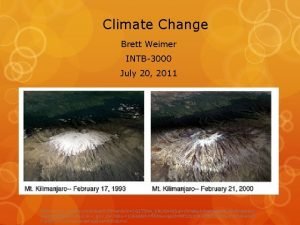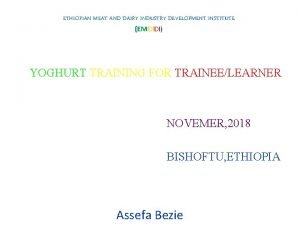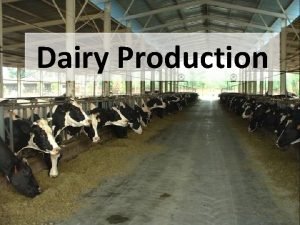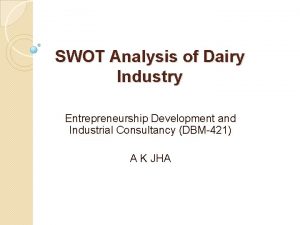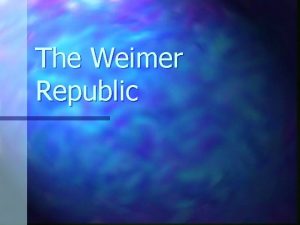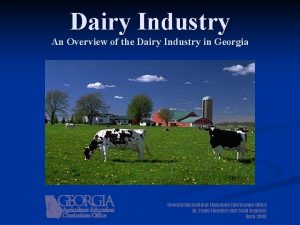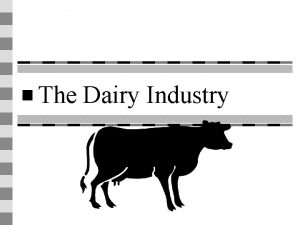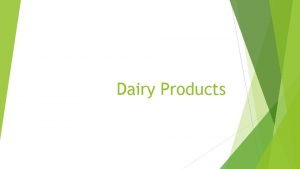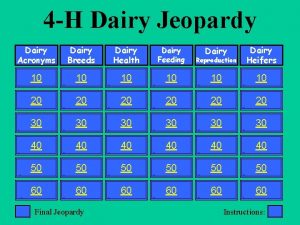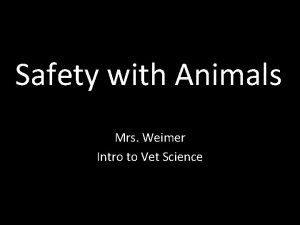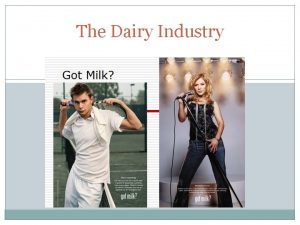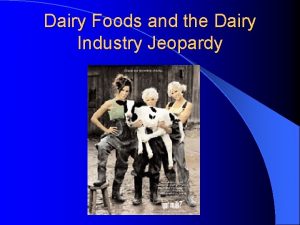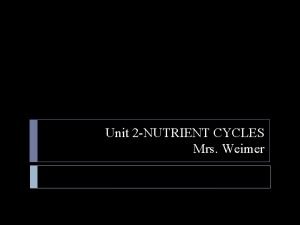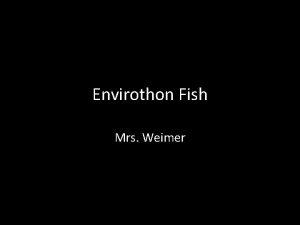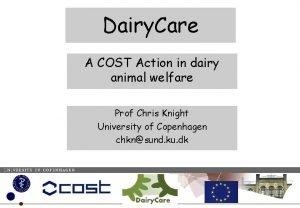Intro to the Dairy Industry Mrs Weimer 1















































- Slides: 47

Intro to the Dairy Industry Mrs. Weimer 1

2

TASK • You and a partner will work together to complete the dairy industry scavenger hunt and answer the questions. 3

TASK Take 5 minutes and brainstorm individually about items that are needed to run a dairy farm. Remember to include equipment, feed, animal supplies, and repairs. Write down as many items as possible that you can in 5 minutes. End

TASK 4 groups (East Coast, Midwest, Northwest, and Southwest). Utilizing the Dairy Regions Factsheet, your group will have 5 minutes to find the following information about your assigned region. End

• Conclusion Questions • 1. If cow numbers continue to decline in the United States, what will happen to the total number of jobs supported by the dairy industry? Why? • 2. List 3 businesses that a dairy farm supports in the local community. • 3. Which region of the country has the fewest number of farms with the largest number of cows per farm? • 4. Choose 2 regions of the country and compare/contrast their characteristics in relation to the dairy industry. 6

7

“The Dairy Industry: Then and Now” 8

I. Current State of Dairy Industry • Comparing past to present Table 1. Characteristics of the 1944 and 2007 Dairy Production Systems Variable 1944 2007 Breed 54% Jersey/Guernsey/Ayrshire 90% Holstein 46% Holstein/Brown Swiss 4, 572 lb 20, 267 lb Milk Yield per cow (lb) Milk Fat Content (%) Milk Protein Content (%) Heifer: cow ratio Age at 1 st calving Breeding method Bull: cow ratio Principal forage sources Diet Type Source: Capper et. al. 2009 4. 20% (small breed) 3. 6% (large breed) 3. 5% (small breed) 3. 69% 3. 05% 3. 2% (large breed) 0. 89: 1 27 months 100% natural service 1 bull: 25 cows pasture, hay 0. 83: 1 25. 5 months 70% AI, 30% natural 1 bull: 83 cows corn silage, alfalfa silage forage & concentrate Total Mixed Ration 9

Discussion of 1944 vs. 2007 • 1944 – 25. 6 billion cows producing 53 billion kg milk – Pasture-based system – Draft horses powered equipment – Little fertilizer used • Manure major source of fertilizer – What does this scenario resemble? 10

Discussion of 1944 vs 2007 • 2007 – 9. 2 billion cows producing 84. 2 kg of milk – Confinement barns are built • Dry cows & heifers have access to pasture – TMR has become the norm – Goals have changed 11

Reasons for Change in Productivity • Change in Major Breeds – Popularity and Performance of Holsteins • Widespread adoption of Artificial Insemination • Improved Genetic Selection & Evaluation – Shook 2006 • “ 55% of the 7, 716 lb per cow increase since 1980 can be attributed to improved genetics” 12

• Change in major breeds • 54% small breeds (Jersey, Guernseys, and Ayrshire) in 1944 to 90% Holstein • In 1944, Holsteins were only 39% of total dairy population • Widespread adoption of AI • With the use of AI, producers had the capability to select a superior bull that he didn’t have to own • By selecting higher producing cows, more milk is made with fewer, but better cows • This also decreased the number of bulls needed since only the best were being used in AI studs • Shook estimates that 55% of the 7, 716 lb increase since 1980 can be attributed to improved genetics and the evaluation of animal TPI 13

Benefits of Improved Productivity Table 2. Comparison of Resource Inputs, Waste Outputs, and Environmental Impact Variable 1944 2007 Milk Production 53. 1 billion kg 84. 2 billion kg Animals to produce 1 billion kg milk Lactating cows 414, 800 93, 600 Dry cows 67, 400 15, 200 Heifers 429, 200 90, 300 Mature bulls 19, 290 1, 310 Total animals 948, 000 202, 000 Nutritional Resources Metabolizable Energy requirement (MJ) 16. 6 billion MJ 3. 87 billion MJ Crude Protein Requirement (kg) 165 billion kg 48. 4 billion kg Land 4. 2 million acres 400, 310 acres Manure Produced 7. 86 billion kg 1. 91 billion kg Gas Emissions Methane (Enteric & Manure) 61. 8 million kg 26. 8 million kg Nitrous Oxide 412, 000 kg 230, 000 kg Carbon Footprint (kg CO 2 Equivalents) Source: Capper et. al. 2009 3. 66 billion kg CO 2 1. 35 billion kg CO 2 14

Reduction of Carbon Footprint Carbon Dioxide per kg of Milk 4 3, 5 3 3, 66 2, 5 2 CO 2 per kg of Milk (in CO 2 equivalents) 1, 5 1 1, 35 0, 5 • When evaluating CO 2 per kg of milk, it is obvious to see how the carbon footprint has decreased • In 2007, we have reduced our carbon footprint by 37% from 1944 0 1944 2007 15

Total GHG Emissions 1944 vs 2007 1944 Total Emissions 2007 Total Emissions 213 tons 125 tons A 41% total reduction in GHG shows the need and importance of how increasing productive efficiency will further decrease dairy production’s environmental impact into the future 16

TASK • • • • Write down 3 changes that have occurred on dairy farms from 1944 to 2014 and reasons why these changes have occurred. Changes 1. Reason(s) Why 2. 3. 17

TASK • There were many individuals that contributed to the development of the dairy industry through research, trial & error, and perseverance. Many discoveries built upon the work of others before them. • Your group will be given a set of Dairy Timeline Cards that outline major advances in the dairy industry beginning in 1611. • Some cards will have a date while others will have a major event/discovery. Working with your group, you must correctly match each event/discovery to the correct date and create a timeline. • You may utilize any internet or textbook resources made available to you by your instructor. 18

PART 3 FACILITIES 19

TASK • USE the words on your notesheet to determine which type of facility is displayed and WHY you think that! 20

Photo #1

Photo #2

Photo #3

Photo #4

Photo #5

Photo #6

TASK with RUBRIC • • • TASK: Imagine you work for Dairy Construction Specialists , a company that specializes in building dairy facilities. You have just had a consult with a young farmer that can’t decide between what type of facility he wants to build. As part of your consulting business, you must consider all of the benefits and consequences of any decision you offer to a customer. Using your knowledge of the 6 types of systems, your supervisor asks you to complete the following: 1. • • Prepare a document that lists 3 “Pros” and 3 “Cons” for each type of facility (Tie-Stall barn, Free-Stall Barn, Stanchion Barn, Robotic Milker, Pack Barn, and Grazing systems. ) 2. • • Create a one-page advertisement for the system that you and your partner would recommend to the young farmer. Be sure to include estimated costs of the project, 3 reasons to build this system, and an overview of the contents of the design (i. e. milking parlor needs, gates, labor) 3. Your group will be presenting your one-page advertisement to the class as directed by your instructor 27

28

Part 4 - Breeds 29

Rainyridge Tony Beauty EX 5 ECan • Black and White or Red and White color pattern • Large sized • Heavy milk producers

Huronia Centurion Veronica EX-97 • Color varies (light gray to a dark fawn being darker around the head and hips) • Medium sized • Produces more pounds of milk per body weight than any other dairy breed.

Westlyn Tom Dee Ex-96 • • Red (Fawn) and White in color Medium sized High milk production to feed intake ratio Milk is high in betacarotene

Old Mill E Snickerdoodle EX-94 • • Solid brown, varying from very light to dark Large sized Light colored band around the muzzle One of the oldest Dairy breeds

Valevue BBV Minerva EX 96 • • Red and white in color (amount varies) Medium sized Purebred Ayrshires only produce red offspring Average milk production

Innisfail BDC Stella 905 EX 96 • • • Red and white or any combination of red and white Dual purpose breed Split from the American Shorthorn Assoc. in 1949

Blondin Redman Seisme EX 96 • Animals with Red and White Coloration • Association was established in 1964 • Rapidly growing segment of the dairy industry!

TASK • Organize the breeds in order of worth

TASK • • • • Choose 1 breed that you would like to describe from your list above. It can be your favorite breed, least favorite, or a new breed that you are interested in learning more about. Your task is to prepare a Public Service Announcement (PSA) that will run on several radio stations to inform the general public about your breed of dairy cows during National Dairy Month, which is June of each year. Assume that the radio listeners have never seen this breed of dairy cow, but you want to catch their attention. Your PSA should be approximately 30 seconds in length (give or take 5 seconds under or over). The PSA must include the following items (at a minimum): _____Color of Breed _____Milk Production Statistics _____Country of Origin _____Three (3) characteristics of the breed _____Two (2) strengths of the breed Submit a written copy and digital copy of your PSA to your instructor as directed. 38

PART 5 -Dairy Careers 39

TASK • You and a partner will look at the dairy careers notesheets and pick out 4 that resonate with you-complete the four boxes on your notesheets 40

TASK • 1. Using one of the jobs you selected above, you will be creating a job description for an open position within the industry. See the sample job posting below. • 2. Your posting must include the following information: • _____Job Title • _____Five (5) Skills required for the job • _____Education or Experience Needed • _____Four (4) Tasks the employee will be expected to perform • _____Deadline for application materials (what items are needed to apply? ) • _____Where to send application materials • Submit your job posting to your instructor as directed. 41

THE INTERVIEW • • • • Part Three—Found a Job…Now What? Now that you know how to interpret a job description, it’s time to practice your interviewing skills to secure your dream job. Your instructor will post various job descriptions around the room that your peers have just created. Take a walk around the room and find a job that meets your interest and take a copy of the job description back to your seat. You will be interviewing for your ‘dream job’ in the dairy industry based on the job description you just selected. Take a few minutes and think about how you meet the requirements for the job. Your instructor will assign you to a partner. You will be interviewed by this partner for your selected job and then the roles will be reversed. To conduct the interview, follow the Interview Guide handout. You will have 5 -7 minutes to conduct each interview. Be sure to complete the “Interview Evaluation” and turn into your instructor as directed. 42

DAIRY – HOW DOES IT GET TO YOU? 43

44

TASK • After viewing the documentary, it’s your turn to “tell the story” of how milk is taken from the farm to the dinner table. You will work with a partner to create a flow chart of the path that milk travels from the farm to the table. • Your poster must include (at a minimum) the following steps of the process: • – – – – • • • Milk Marketing Homogenization Pasteurization Packaging Transportation (to store) Transportation (farm to plant) Milk Production Be sure to display the steps of the process in the correct order. You must describe what happens at each step in the process. Provide illustrations of each step, if possible. – The following website is a valuable tool for this project: http: //westerndairyassociation. org/dairy-farms/how-milk-goes-from-our -cows-to-your-table/ • Hang up your poster as instructed by your teacher. • Complete a “Gallery Walk” to view other groups’ work. 45

DAIRY PRODUCTS 46

47
 Brett weimer
Brett weimer Brett weimer
Brett weimer Melissa weimer
Melissa weimer Emdidi
Emdidi Objectives of dairy farming
Objectives of dairy farming Wastewater treatment for dairy industry
Wastewater treatment for dairy industry Swot analysis of dairy industry
Swot analysis of dairy industry They are mrs garcia and mrs castro
They are mrs garcia and mrs castro Mrs. darling was ___________ of mrs. s.
Mrs. darling was ___________ of mrs. s. They are mrs garcia and mrs castro
They are mrs garcia and mrs castro Diễn thế sinh thái là
Diễn thế sinh thái là V. c c
V. c c Frameset trong html5
Frameset trong html5 Làm thế nào để 102-1=99
Làm thế nào để 102-1=99 Hát lên người ơi
Hát lên người ơi Lời thề hippocrates
Lời thề hippocrates Sự nuôi và dạy con của hổ
Sự nuôi và dạy con của hổ đại từ thay thế
đại từ thay thế Quá trình desamine hóa có thể tạo ra
Quá trình desamine hóa có thể tạo ra Vẽ hình chiếu vuông góc của vật thể sau
Vẽ hình chiếu vuông góc của vật thể sau Công thức tính thế năng
Công thức tính thế năng Thế nào là mạng điện lắp đặt kiểu nổi
Thế nào là mạng điện lắp đặt kiểu nổi Dot
Dot Bổ thể
Bổ thể Vẽ hình chiếu đứng bằng cạnh của vật thể
Vẽ hình chiếu đứng bằng cạnh của vật thể Phản ứng thế ankan
Phản ứng thế ankan Môn thể thao bắt đầu bằng chữ đua
Môn thể thao bắt đầu bằng chữ đua Khi nào hổ mẹ dạy hổ con săn mồi
Khi nào hổ mẹ dạy hổ con săn mồi điện thế nghỉ
điện thế nghỉ Một số thể thơ truyền thống
Một số thể thơ truyền thống Biện pháp chống mỏi cơ
Biện pháp chống mỏi cơ Trời xanh đây là của chúng ta thể thơ
Trời xanh đây là của chúng ta thể thơ So nguyen to
So nguyen to Thiếu nhi thế giới liên hoan
Thiếu nhi thế giới liên hoan Tỉ lệ cơ thể trẻ em
Tỉ lệ cơ thể trẻ em Vẽ hình chiếu vuông góc của vật thể sau
Vẽ hình chiếu vuông góc của vật thể sau Các châu lục và đại dương trên thế giới
Các châu lục và đại dương trên thế giới Thế nào là hệ số cao nhất
Thế nào là hệ số cao nhất Hệ hô hấp
Hệ hô hấp Tư thế ngồi viết
Tư thế ngồi viết Cái miệng bé xinh thế chỉ nói điều hay thôi
Cái miệng bé xinh thế chỉ nói điều hay thôi Hình ảnh bộ gõ cơ thể búng tay
Hình ảnh bộ gõ cơ thể búng tay đặc điểm cơ thể của người tối cổ
đặc điểm cơ thể của người tối cổ Mật thư anh em như thể tay chân
Mật thư anh em như thể tay chân Thang điểm glasgow
Thang điểm glasgow Tư thế ngồi viết
Tư thế ngồi viết ưu thế lai là gì
ưu thế lai là gì Gấu đi như thế nào
Gấu đi như thế nào
